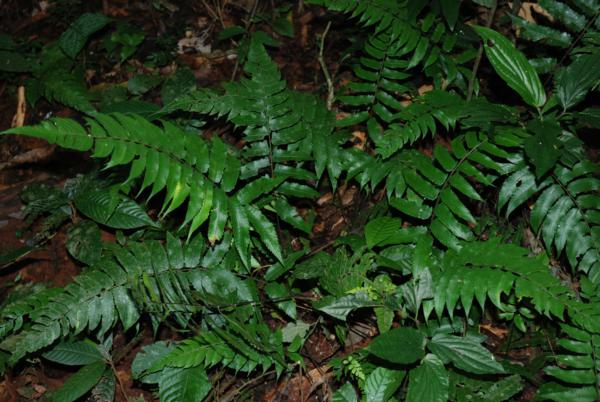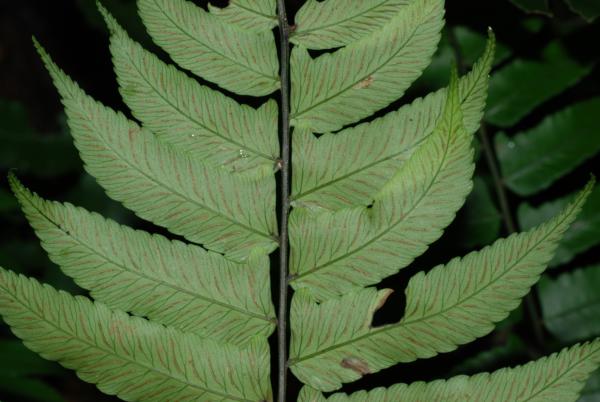
Diplazium silvaticum (Bory) Sw.
Family
Athyriaceae
Nomenclature
Diplazium silvaticum (Bory) Sw., Syn. Fil.: 92. 1806; Bedd., Handb. Ferns Brit. India.: 177. 1883; Christ, Bot. Tidsskr. 24: 108. 1901; C.Chr., Bot. Tidsskr. 32: 346. 1916; Holttum, Gard. Bull. Straits Settlem. 11: 99. 1940; Tagawa & K.Iwats., SouthE. Asian Stud. 3(3): 87. 1965; Tagawa & K.Iwats., SouthE. Asian Stud. 5: 104. 1967; Tagawa & K.Iwats., Acta Phytotax. Geobot. 23: 56. 1968; Tagawa & K.Iwats., Fl. Thailand 3: 459. 1988; Boonkerd & Pollawatn, Pterid. Thailand: 195. 2000. – Callipteris silvaticum Bory, Voy. Iles Afrique 1: 282. 1804.
Athyrium pinnatum (Blanco) Copel., Philipp. J. Sci., Sect. C, Botany 3: 297. 1908; Holttum, Rev. Fl. Malaya ed. 1, 2: 560, f. 331. 1955 [‘1954’]; Holttum, Dansk Bot. Ark. 20: 32. 1965.
Description
Description adapted from Holttum, Rev. Fl. Malaya ed. 1, 2: 560, f. 331. 1955 [‘1954’].Rhizome short, erect. Scales on young fronds and bases of stipes very dark, to about 10 mm long and 1.5 mm wide, closely and distinctly toothed, teeth often forked. Stipes to about 40 cm long. Frond simply pinnate, to about 50 by 20 cm, pinnae numerous, lower stalked to about 5 mm, upper sessile; bulbil sometimes present on rachis near apex; lowest pinnae with upper base subtruncate, lower base cuneate; upper pinnae with base broadly cuneate to truncate, more or less auricled above but not below; pinnae to about 12 cm long and 3–4.5 cm wide (commonly less), apex acuminate, edges lobed to about 1/4 distance to costa, texture thin; lobes oblique, about 5 mm wide, veins in pinnate groups with 3–4 pairs of lateral veins; sori from near base of veins 3/4 or more towards edge, sorus on acroscopic basal vein diplazioid, sometimes sorus on next acroscopic vein also, other sori simple .
Distribution in Thailand
NORTHERN: Phitsanulok; NORTH EASTERN: Loei; SOUTH-EASTERN: Chanthaburi, Trat; PENINSULAR: Chumphon, Surat Thani, Phangnga, Krabi, Nakhon Si Thammarat, Trang, Satun, Yala.
Wider Distribution
Mauritius, India, Burma, Peninsular Malaysia, Borneo, Java, and Philippines.
Ecology
On mountain slopes usually in moist places in dense evergreen forests at low to medium elevations below 1200 m alt.
Similar species
Diplazium crenatoserratum (Blume) T.Moore
Diplazium mettenianum (Miq.) C.Chr.
Proposed IUCN Conservation Assessment
Least Concern (LC). This species is widespread and not under any known threat.
Habit
Lower surface of lamina
Site hosted by the Royal Botanic Garden Edinburgh. Content managed by Stuart Lindsay, Gardens by the Bay, Singapore and David Middleton, Singapore Botanic Gardens. Last updated 24 January 2012

